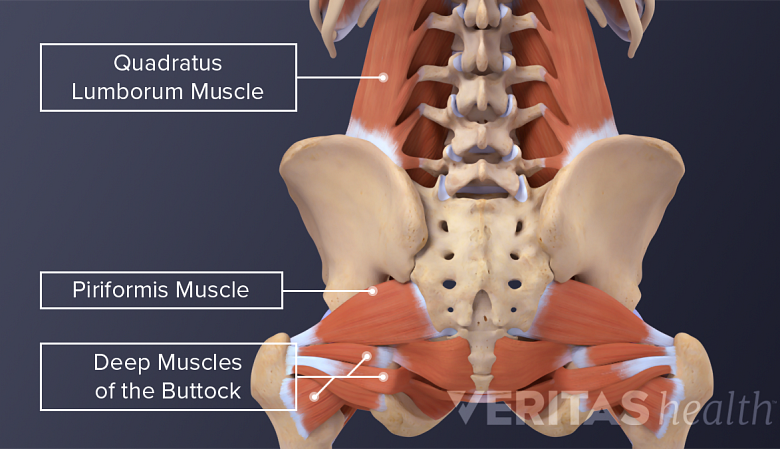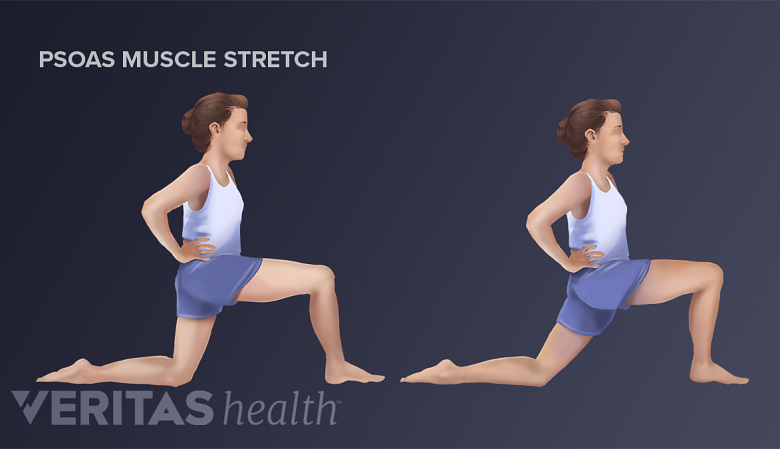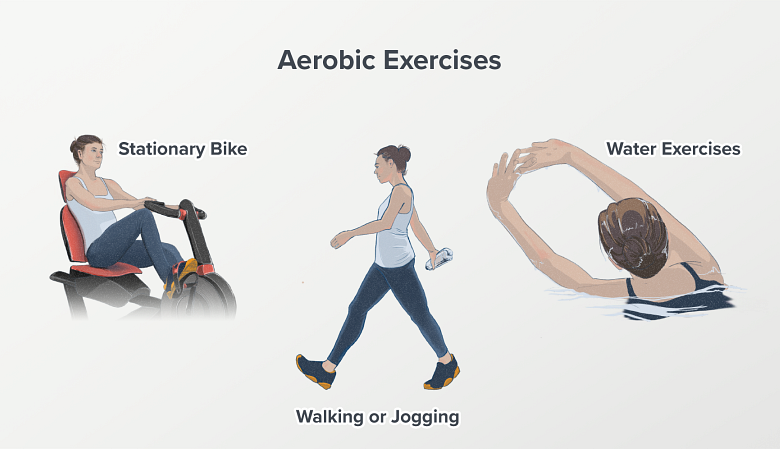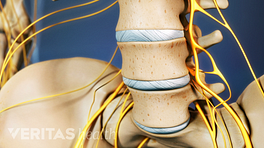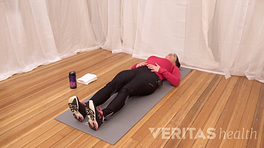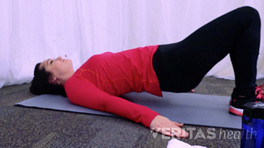A regular exercise routine is almost always a core component of any degenerative disc disease treatment program. Spinal movement and exercise deliver several important benefits, including pain reduction, delivery of nutrients to the spine to nourish discs, muscles, ligaments, and joints and developing strength to support and hold up the spine.
The primary goals of a physical therapy program are two-fold:
- To reduce the severity of the low back pain and attendant leg pain
- To minimize the severity and duration of any pain flare-ups that are common with this condition.
An exercise or physical therapy program is best done as a controlled, gradual, and progressive series of exercises. For those who cannot participate in active treatments due to severe pain, water therapy may be recommended. The buoyancy of water is particularly useful for exercises that require lifting the legs.
Before starting a new exercise program, it is advisable for patients to first see a spine specialist who is trained in developing individualized back exercise programs and in instructing patients in using the correct form and technique for each exercise. Low back pain exercise regimens vary widely, depending on the patient's diagnosis and level of pain.
In This Article:
- Degenerative Disc Disease Treatment for Low Back Pain
- Exercise and Physical Therapy for Disc Disease Treatment and Pain Management
- Pain Medications for Degenerative Disc Disease Treatment
- Pain Management Techniques for Degenerative Disc Disease
- Treating Chronic Pain and Depression from Degenerative Disc Disease
Stretching to Relieve Low Back Pain
Regularly stretching the muscles of the lower back improves spinal mobility and flexibility.
The spinal column, along with all the connected muscles, ligaments, and tendons, works to provide motion to the body. Limited range of motion in the back may contribute to low back pain, and stretching is designed to recover range of motion.
Recommended stretches typically target some combination of the following muscles:
- Abdominal muscles
- Erector spinae muscles
- Psoas major muscle
- Gluteal muscles
- Quadricep and hamstring muscles
In individuals with chronic lower back pain from degenerative disc disease, muscles that support the trunk tend to have common characteristics, such as decreased cross-sectional areas of muscles and increased fat content within the muscles. 1 Fortin M, Macedo LG. Multifidus and paraspinal muscle group cross-sectional areas of patients with low back pain and control patients: a systematic review with a focus on blinding. Phys Ther. 2013;93(7):873-888. doi:10.2522/ptj.20120457 , 2 Sions JM, Elliott JM, Pohlig RT, Hicks GE. Trunk Muscle Characteristics of the Multifidi, Erector Spinae, Psoas, and Quadratus Lumborum in Older Adults With and Without Chronic Low Back Pain. J Orthop Sports Phys Ther. 2017;47(3):173-179. doi:10.2519/jospt.2017.7002 , 3 Ranger TA, Cicuttini FM, Jensen TS, et al. Are the size and composition of the paraspinal muscles associated with low back pain? A systematic review. Spine J. 2017;17(11):1729-1748. doi:10.1016/j.spinee.2017.07.002 , 4 Arbanas J, Pavlovic I, Marijancic V, et al. MRI features of the psoas major muscle in patients with low back pain. Eur Spine J. 2013;22(9):1965-1971. doi:10.1007/s00586-013-2749-x Regular stretching of these target muscles and the lower back improves the spine’s mobility and range of motion.
While it may take several weeks or months of regular stretching to see improvement, patients with chronic low back pain often find that increased range of motion in their low back leads to relief of their low back pain.
Hamstring stretches
Hamstring stretches promote flexibility and reduce muscle tightness in the lower back and legs.
Tight hamstrings, the large muscles in the back of the thigh, are associated with an increased risk of developing low back pain. 5 Sadler SG, Spink MJ, Ho A, De Jonge XJ, Chuter VH. Restriction in lateral bending range of motion, lumbar lordosis, and hamstring flexibility predicts the development of low back pain: a systematic review of prospective cohort studies. BMC Musculoskelet Disord. 2017;18(1):179. Published 2017 May 5. doi:10.1186/s12891-017-1534-0 While it is not yet understood in which way the causal relationship flows, it is known that hamstring tightness limits motion in the pelvis and can place the pelvis in a position that increases stress across the low back. 6 Jandre Reis FJ, Macedo AR. Influence of Hamstring Tightness in Pelvic, Lumbar and Trunk Range of Motion in Low Back Pain and Asymptomatic Volunteers during Forward Bending. Asian Spine J. 2015;9(4):535-540. doi:10.4184/asj.2015.9.4.535
A regular program of hamstring stretching will typically ease the intensity of low back pain and the frequency of recurring flare-ups. There are a variety of hamstring stretching techniques that are gentle on the low back, such as sitting on a chair and placing one leg on another chair to gently stretch the hamstring.
Psoas major muscle stretches
Psoas muscle stretching exercises can help alleviate lower back pain and improve hip flexibility.
A tight psoas major muscle (located at the front of the lower spine) limits movement in the lower back. The size of the psoas major may be important in low back pain. A smaller psoas major muscle at the spinal segment L5 has been linked to higher levels of disability. 7 Mannion AF, Junge A, Taimela S, Müntener M, Lorenzo K, Dvorak J. Active therapy for chronic low back pain: part 3. Factors influencing self-rated disability and its change following therapy. Spine (Phila Pa 1976). 2001;26(8):920-929. doi:10.1097/00007632-200104150-00015
This muscle can be stretched by:
- Kneeling on the ground, with knees aligned under the hips
- Moving one leg out in front, with the thigh parallel to the ground and the leg bent at a 90-degree angle
- Rotating the front leg outward, while tightening the gluteal muscles
- Leaning forward through the hip joints, rather than bending through the lumbar spine
Bending the upper body to the side, away from the knee that is kneeling, will stretch the muscle even further if needed. The stretch will be felt at the front of the hip, on the side of the kneeling knee.
Core Strengthening Exercises for Lower Back Pain
Core strengthening exercises aim to strengthen the muscles in the hips and lower back.
The core strengthening muscles are a group of muscles located on the trunk of the body. These muscles serve several vital functions: support the lower spine, bear the heavy load of the upper body, and allow everyday movements such as lifting heavy objects and walking.
Many methods and exercises may be used to strengthen the core muscles. Three commonly used approaches for people with lumbar degenerative disc disease include:
- Dynamic lumbar stabilization, which strengthens the lumbar extensor muscles that allow the body to stand upright
- Exercise ball therapy, which may include advanced stabilization exercises, such as exercise ball bridges
- Floor exercises, such as pelvic tilts, which primarily strengthen abdominal muscles, and leg raises, which strengthen the core, lower back, and hip flexors
Watch Sciatica Exercises for Degenerative Disc Disease Video
Benefits of core strengthening exercises also include enhanced muscular control of the spine, which generally leads to a significant reduction in localized pain in the lower back or radiating pain from the lower back downwards.
Low-Impact Aerobic Conditioning
Low-impact aerobic exercise boosts blood flow, aids in healing, and alleviates back stiffness.
Exercises that increase the heart rate and blood flow—without jarring the spine—help to rehabilitate and maintain the lower back. Aerobically fit patients will have fewer episodes of low back pain and will experience less pain when an episode occurs.
Examples of low-impact aerobic exercises that are gentle on the low back include:
- Water exercises (also called pool therapy or aquatic therapy)
- Stationary exercise biking
- Exercise walking (including walking on a treadmill)
- Elliptical trainer
The ability to perform everyday activities may gradually improve with aerobic conditioning exercises. Staying active with regular, simple stretches and exercises is paramount for alleviating chronic low back pain.
For people in severe pain, it may be more tolerable to start exercising in a warm pool, as the buoyancy of the water helps hold up the body while also providing gentle resistance to build strength.
Lower back exercise regimens vary widely depending on the patient's diagnosis and level of pain. Before starting a new exercise program, it is advisable to consult a spine specialist who is trained in developing individualized back exercises.
- 1 Fortin M, Macedo LG. Multifidus and paraspinal muscle group cross-sectional areas of patients with low back pain and control patients: a systematic review with a focus on blinding. Phys Ther. 2013;93(7):873-888. doi:10.2522/ptj.20120457
- 2 Sions JM, Elliott JM, Pohlig RT, Hicks GE. Trunk Muscle Characteristics of the Multifidi, Erector Spinae, Psoas, and Quadratus Lumborum in Older Adults With and Without Chronic Low Back Pain. J Orthop Sports Phys Ther. 2017;47(3):173-179. doi:10.2519/jospt.2017.7002
- 3 Ranger TA, Cicuttini FM, Jensen TS, et al. Are the size and composition of the paraspinal muscles associated with low back pain? A systematic review. Spine J. 2017;17(11):1729-1748. doi:10.1016/j.spinee.2017.07.002
- 4 Arbanas J, Pavlovic I, Marijancic V, et al. MRI features of the psoas major muscle in patients with low back pain. Eur Spine J. 2013;22(9):1965-1971. doi:10.1007/s00586-013-2749-x
- 5 Sadler SG, Spink MJ, Ho A, De Jonge XJ, Chuter VH. Restriction in lateral bending range of motion, lumbar lordosis, and hamstring flexibility predicts the development of low back pain: a systematic review of prospective cohort studies. BMC Musculoskelet Disord. 2017;18(1):179. Published 2017 May 5. doi:10.1186/s12891-017-1534-0
- 6 Jandre Reis FJ, Macedo AR. Influence of Hamstring Tightness in Pelvic, Lumbar and Trunk Range of Motion in Low Back Pain and Asymptomatic Volunteers during Forward Bending. Asian Spine J. 2015;9(4):535-540. doi:10.4184/asj.2015.9.4.535
- 7 Mannion AF, Junge A, Taimela S, Müntener M, Lorenzo K, Dvorak J. Active therapy for chronic low back pain: part 3. Factors influencing self-rated disability and its change following therapy. Spine (Phila Pa 1976). 2001;26(8):920-929. doi:10.1097/00007632-200104150-00015

